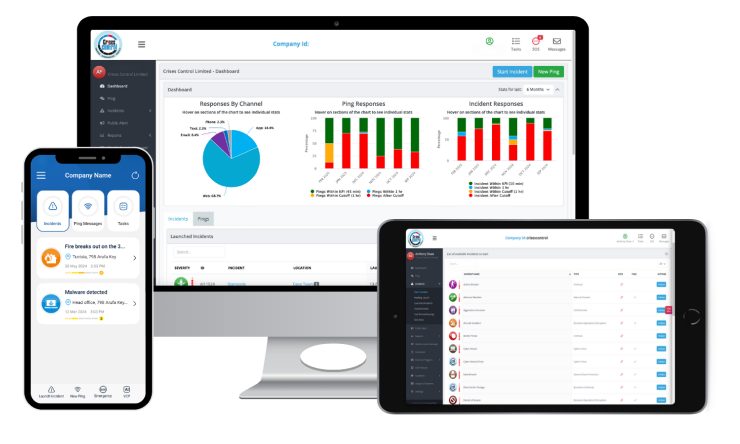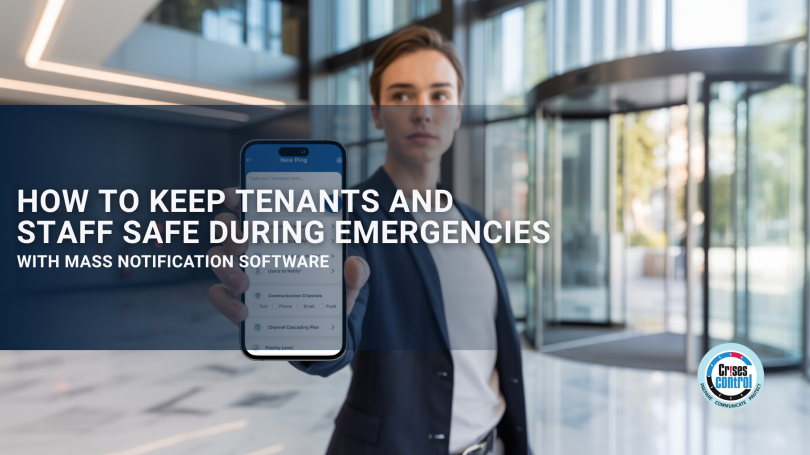Written by Anneri Fourie | Crises Control Executive
When an emergency happens in a building, confusion spreads quickly. Alarms sound, people start to panic, and communication breaks down. For property managers and facility owners, this moment defines how well-prepared their organisation really is. Getting accurate information to tenants and staff fast can mean the difference between calm coordination and chaos.
The problem is that during critical incidents such as fires, gas leaks, floods, or security threats, traditional communication methods often fail. Phone calls go unanswered, emails are missed, and messages spread inconsistently. The result is frustration, uncertainty, and risk.
This is where Mass Notification Software offers a clear solution. For property managers, landlords, and facilities teams, a system like Crises Control makes emergency communication simple and structured. It ensures that every person receives the right information at the right time, helping protect lives and keep operations moving.
Why Real Estate Professionals Need Mass Notification Software
Emergencies in residential and commercial properties can happen without warning. Whether it is a burst pipe in a basement, a fire alarm in an office, or a power outage in a high-rise block, fast coordination is essential. The challenge is reaching everyone who needs to know and managing their responses effectively.
Using a Mass Notification Software system centralises all communication in one place. Instead of juggling calls, emails, and text messages, property teams can send instant alerts across multiple channels including SMS, push notifications, voice calls, and emails. Messages reach every tenant, staff member, and emergency contact within seconds.
For real estate professionals, this approach provides several practical benefits:
- Instant communication to on-site and off-site contacts
- A single platform to manage all alerts and responses
- Automatic record keeping for compliance and audits
- Clear, real-time visibility of an unfolding situation
Crises Control makes this process even easier. Property managers can create pre-set incident templates and defined response groups, so that when something goes wrong, alerts are triggered immediately with just one click.
Real-Time Incident Alerts That Protect People
Emergencies move fast, and delays in response can increase risk. Real-time incident alerts give property managers the power to detect, respond, and communicate almost instantly. When a fire alarm triggers or a leak is detected, the system sends alerts to all relevant people at once, from maintenance teams to tenants and emergency services.
These alerts are interactive, not one-way messages. People can confirm they are safe, ask for help, or share updates about what is happening around them. This creates a live overview of the situation, giving managers reliable information instead of guesswork.
Crises Control can also integrate with existing building systems such as fire panels, access control, or environmental sensors. For instance, if smoke is detected on a specific floor, the system can automatically send evacuation instructions to tenants in that area, alert fire wardens, and notify the facilities manager.
Automation like this reduces reaction time and ensures every action is logged. That record becomes valuable when proving compliance to regulators or reviewing performance after an incident.
Keeping Track of Everyone During Evacuations
When large buildings need to be evacuated, keeping track of people is one of the hardest tasks. Manual roll calls often fail because people exit from different routes or gather in various assembly points. The Employee Mass Notification System within Crises Control helps eliminate this uncertainty.
Every person receives a safety message asking them to confirm they are safe or if they need help. Their responses are shown in real time on a dashboard so property managers can see exactly who has checked in and who may still be inside.
This not only speeds up rescue efforts but also provides documentation that supports compliance with laws such as the UK Fire Safety Order and the Health and Safety at Work Act. Similar benefits apply in regions such as the Middle East, the USA, and Canada, where detailed accountability records are required during investigations or insurance claims.
Evacuation tracking is not just about compliance. It builds trust with tenants and staff, reassuring them that their safety is taken seriously and that there is a reliable plan in place for when things go wrong.
Improving Personal Safety with the SOS Panic Button
Not every emergency involves a building-wide evacuation. Maintenance staff, cleaners, or security officers often work alone or at unsociable hours, facing unique risks. Crises Control’s SOS panic button gives them a fast and discreet way to ask for help.
By pressing a single button in the mobile app, users send an alert to chosen contacts or a control room. The alert includes their exact GPS location and opens a two-way communication channel, allowing the responder to assess the situation immediately.
This feature offers practical safety support for lone workers and demonstrates an employer’s commitment to health and safety obligations. It also brings peace of mind to staff who know that help can be reached quickly if they face danger, feel unwell, or encounter an incident while on duty.
Integrating Workplace Safety Software with Building Systems
Modern properties rely on a mix of technologies such as CCTV, fire alarms, access controls, and environmental sensors. The challenge is that many of these systems operate independently, which can slow down response times when emergencies happen.
By using Workplace Safety Software like Crises Control, property managers can connect these systems so they work together. When an alert is triggered, Crises Control automatically launches the right communication workflow.
This can include:
- Notifying emergency services and property teams
- Sending evacuation alerts to affected zones
- Restricting access to unsafe areas
- Updating dashboards with live response data
This level of coordination makes emergency management simpler and more effective. It ensures that the right people are informed, actions are consistent, and every decision is recorded.
Meeting Real Estate Compliance and Safety Obligations
Regulatory compliance varies by region, but one principle is universal: property owners must protect the people in their buildings. Communication failures during an emergency can lead to serious consequences including legal liability, penalties, and loss of reputation.
Crises Control helps real estate organisations meet these responsibilities across several key frameworks:
- United Kingdom: Fire Safety Order, Health and Safety at Work Act, and GDPR
- European Union: Occupational Safety Directive and EU Building Codes
- United States: OSHA, NFPA, ADA, and state fire codes
- Middle East: Civil Defence Codes and Occupational Health and Safety laws
- Canada: Provincial Fire Codes and Occupational Health and Safety Regulations
Built-in reporting and audit trails ensure every communication and action is recorded for compliance checks. Managers can also schedule drills, track participation, and assess how well their teams respond. This provides evidence of compliance and supports continuous improvement.
For readers who want to strengthen their wider emergency management approach, you can also explore our previous guide on Creating a Crisis Management Plan for Real Estate.
Mass Notification System for Real Estate: Real Examples in Action
To see how a Mass Notification System for Real Estate works in real scenarios, consider these examples from everyday property management:
Major Fire in a Commercial Building
A fire alarm sounds on the third floor of an office complex. Within moments, Crises Control sends evacuation alerts to everyone in the building, notifies the fire service, and tracks responses. Managers can see who has confirmed safety and which areas still need to be cleared.
Gas Leak in a Residential Block
A maintenance team detects a gas leak. The property manager uses Crises Control to send instructions to tenants, restrict access to the affected zone, and coordinate with emergency services. All communication is logged automatically for regulatory review.
Flooding or Water Main Break
A burst pipe threatens basement equipment. Using predefined message templates, the manager alerts repair teams, informs tenants about temporary restrictions, and updates insurers through a clear communication chain.
Security Breach or Intruder Alert
Security staff spot an unauthorised person entering the building. Lockdown messages are sent instantly to tenants and staff while law enforcement is informed. Managers can follow real-time updates and confirm when the building is secure again.
In each of these cases, Crises Control replaces confusion with clarity and gives property managers complete visibility of the situation.
Creating a Culture of Preparedness
Technology alone cannot keep people safe unless everyone knows how to use it. Building a culture of preparedness means making emergency communication part of everyday operations.
Property managers can use Crises Control to run regular fire and evacuation drills, ensure contact lists are up to date, and train staff and tenants on how alerts work. These small steps create confidence and familiarity, which are invaluable when a real emergency occurs.
When tenants and staff trust the system and know what to do, responses are faster, calmer, and more effective. This not only protects lives but also strengthens the reputation of the property management company as a responsible and safety-conscious organisation.
Take Control of Safety with Crises Control
Emergencies can strike at any time, but communication should never fail when it matters most. Whether you manage residential properties, commercial facilities, or large mixed-use developments, Crises Control gives you the tools to keep people safe and informed.
From Mass Notification Software and Employee Mass Notification Systems to real-time incident alerts and the SOS panic button, Crises Control helps you act quickly and confidently in any situation.
If you want to improve your building safety and emergency response, request a free demo to see how Crises Control can help you protect your tenants, staff, and assets.
Request a FREE Demo

